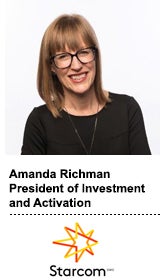Amanda Richman, president of activation and investment at Publicis Groupe’s Starcom, used to mostly negotiate rates with TV networks.
Today, she helps clients navigate spend on walled gardens, vet ad tech partners and use data to make smarter media buys.
“There’s a deep relationship with investment in media inventory and investment from a tech and data perspective,” she told AdExchanger at the 4A’s Transformation show in Los Angeles on Monday.
As client investment strategies shift, Starcom has gone through its own transformation as part of a broader restructuring at Publicis Groupe to consolidate agency brands and bring programmatic inside of its media agencies.
Richman spoke with AdExchanger.
AdExchanger: How have investments in digital and programmatic grown at Starcom since Publicis Groupe restructured?
AMANDA RICHMAN: We needed to put data at the center and make sure our talent was well-versed in activation for smarter targeting, and about how data empowers user experiences.
[We brought] together the media agencies as Publicis Media Exchange to better leverage our clout in the marketplace and drive value for clients.
What is Starcom’s programmatic offering and how has it grown since the disaggregation of VivaKi?
The majority of programmatic activation is [done] at Starcom, but we buy in models that best suit client needs.
We have a center called Precision that drives best practices and helps us think through different models, build technology, form data partnerships and evaluate platforms. It’s a knowledge center of everyone who touches programmatic across Publicis Media.
How do you help your clients decide where to invest across walled gardens?
It starts with understanding consumer behavior, the opportunity for scale and reach against that audience and the purpose the platform plays. In some cases, it’s merely reach that’s complementary to other efforts. We’re also looking at platform-specific creative versus repurposing TV spots that don’t take into account the nuances of sharing and viewing.
How is consolidation in the ad tech space affecting your investment strategy?
It’s lending some level of simplification. We’re anxious to see successful integration of partners, whether that’s TubeMogul with Adobe or Verizon [with AOL and Yahoo]. The opportunity to add scale and resources and create the best technology versus a bolt on can be a great advantage for our clients.
How will you approach investment as we head into the upfronts this year?
[We’re] looking at the role data plays to better understand what inventory is of value to clients and how we can find them across our media partners’ ecosystem as they bring digital and traditional TV together and launch audience index products.
We’re also seeing the development of content studios, which we can access to develop more relevant messaging. There’s an opportunity to work with these players as we move into precise targeting across screens with smarter, platform-specific messaging. The hope is we’re also pushing further with holistic measurement and understanding user behavior across experiences, ad formats and environments.
Is advanced TV becoming a bigger investment area for Starcom? Are you seeing major budget shifts from clients?
Similar to how we thought about digital or programmatic, we had an advanced TV team at the center as we incubated our expertise. As we’ve evolved into Publicis Media, we’ve brought activation into the agencies knowing the future is addressable and programmatic.
We’re seeing dollars start to flow to these opportunities with performance. We can start scaling our own efforts as client teams look not just at addressable TV but over-the-top TV and video-on-demand opportunities.
Do you ever get paid based on performance?
A bigger question is how do we look at new compensation models? What’s the right compensation structure to award strong performance for driving business, not merely hours spent servicing the business and delivering on the KPIs from a full-time employee (FTE) basis?
The challenge is defining KPIs that both marketers and agencies are aligned to and understanding the ability to influence and control that to be rewarded for full performance.
We can drive and optimize media decisions but the accountability to the creative message, which does impact performance, may not live in a media agency. How do we best value all the contributions that drive sales and link compensation to that?
What will happen if agencies can’t evolve their payment models?
That decision will lie in the clients’ hands. For some, simplicity reigns and commissions are simplistic. FTEs may be a bit more complex but still an easily measurable model. Performance is more challenging but it can offer clients tremendous upside in knowing there’s equal skin in the game.
Edited for clarity and length.















